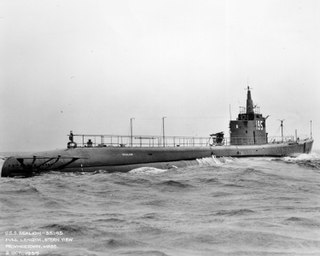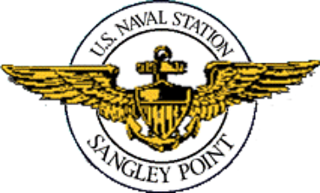
The Battle of Manila Bay, also known as the Battle of Cavite, took place on 1 May 1898, during the Spanish–American War. The American Asiatic Squadron under Commodore George Dewey engaged and destroyed the Spanish Pacific Squadron under Contraalmirante Patricio Montojo. The battle took place in Manila Bay in the Philippines, and was the first major engagement of the Spanish–American War. The battle was one of the most decisive naval battles in history and marked the end of the Spanish colonial period in Philippine history.

USS Sealion (SS-195), a Sargo-class submarine, was the first ship of the United States Navy to be named for the sea lion, any of several large, eared seals native to the Pacific.

The first USS Chauncey was a Bainbridge-class destroyer, also referred to as a "Torpedo-boat destroyer", in the United States Navy named for Commodore Isaac Chauncey. She was launched in 1901 and sunk in 1917.

USS S-14 (SS-119) was a second-group S-class submarine of the United States Navy. Her keel was laid down on 7 December 1917 by the Lake Torpedo Boat Company in Bridgeport, Connecticut. She was launched on 22 October 1919 sponsored by Mrs. George T. Parker, and commissioned on 11 February 1921 with Lieutenant Commander Charles A. Lockwood, Jr., in command.

Kawit, officially the Municipality of Kawit,, is a 1st class municipality in the province of Cavite, Philippines. According to the 2015 census, it has a population of 83,466 people.

USS Pampanga (PG-39) was a schooner-rigged iron gunboat in the United States Navy during the Philippine-American War. She retained her Spanish name.

The Philippine Navy is the naval warfare service branch of the Armed Forces of the Philippines. It has an estimated strength of 24,000 active service personnel, including the 7,500-strong Philippine Marine Corps. It shares the responsibility of patrolling the maritime borders with the Philippine Coast Guard, a formerly attached unit which became a separate maritime law enforcement agency in 1998.

Mendez, officially the Municipality of Mendez-Nuñez,, is a 4th class municipality in the province of Cavite, Philippines. According to the 2015 census, it has a population of 31,529 people.
The naval Battle of Puerto de Cavite took place on 10 June 1647 during the Eighty Years' War between a Spanish fleet and a Dutch fleet in Puerto de Cavite, an important Spanish port in Manila Bay, Philippines in which the Dutch were defeated.

The second USS Monterey (BM‑6) was the sole Monterey-class monitor. Laid down by Union Iron Works, San Francisco, California, 20 December 1889, she was launched 28 April 1891, sponsored by Miss Kate C. Gunn. She was commissioned 13 February 1893, with Captain Lewis Kempff in command.
Joseph Emilio "Jun" Aguinaldo Abaya is a Filipino politician, lawyer, and military officer. He was the Secretary of the Department of Transportation and Communications (DOTC) of the Philippines under the administration of President Benigno Aquino III. A member of the Liberal Party, he has been elected to three terms as a member of the Philippine House of Representatives, representing the 1st District of Cavite. He first won election to the House in 2004, and was re-elected in 2007. He and other Aquino administration officials have been charged over the alleged anomalous contracts for the Metro Rail Transit Line 3 (MRT3) during their time.

Cañacao Bay is a small bay located within the larger Manila Bay in Luzon island in the Philippines.

Naval Station Sangley Point was a communication and hospital facility of the United States Navy which occupied the northern portion of the Cavite City peninsula and is surrounded by Manila Bay, approximately eight miles southwest of Manila, the Philippines. The station was a part of the Cavite Navy Yard across the peninsula. The naval station had a runway that was built after World War II, which was used by U.S. Navy Lockheed P-2 Neptune, Lockheed P-3 Orion, and Martin P4M Mercator maritime patrol and anti-submarine warfare aircraft. An adjacent seaplane runway, ramp area and seaplane tender berths also supported Martin P5M Marlin maritime patrol aircraft until that type's retirement from active naval service in the late 1960s. NAS Sangley Point/NAVSTA Sangley Point was also used extensively during the Vietnam War, primarily for U.S. Navy patrol squadrons forward deployed from the United States on six-month rotations. The naval station was turned over to the Philippine government in 1971. It is now operated by the Philippine Air Force and Philippine Navy.

Naval Base Subic Bay was a major ship-repair, supply, and rest and recreation facility of the Spanish Navy and subsequently the United States Navy located in Zambales, Philippines. The base was 262 square miles, about the size of Singapore. The Navy Exchange had the largest volume of sales of any exchange in the world, and the Naval Supply Depot handled the largest volume of fuel oil of any navy facility in the world. The naval base was the largest overseas military installation of the United States Armed Forces after Clark Air Base in Angeles City was closed in 1991. Following its closure in 1992, it was transformed into the Subic Bay Freeport Zone by the Philippine government.

Danilo Atienza Air Base is a military base used by the Philippine Air Force, located on the northern end of Cavite Peninsula in Manila Bay, Luzon Island, the Philippines. It is adjacent to Cavite City, in Cavite Province.

Naval Station Pascual Ledesma, also known as Cavite Naval Base or Cavite Navy Yard, is a military installation of the Philippine Navy in Cavite City in the Province of Cavite. The 9-hectare (22-acre) naval base is located at the easternmost end of Cavite Point in the San Roque district of the city. It was the former U.S. Naval Station Sangley Point, transferred to the Philippines in 1971. In 2009 it was named after Cmdre. Pascual Ledesma, a leader of the Philippine revolution and the first Officer-In-Command of the Philippine Navy.

Fort San Felipe is a military fortress in Cavite City, in the Province of Cavite, Philippines. It was constructed by Spanish military in 1609 in the first port town of Cavite, the historic core of the present and larger Cavite City, for its protection. Less than half of the original historic structure survives today. The remaining structure is made of granite blocks with 30-foot high walls and features a wide stairway leading to the top of the bastions and remaining walls. Naval memorabilia including antique cannons and cannonballs decorate the lawns of the fortification. Fort San Felipe is located within the 9-hectare (22-acre) Naval Base Cavite of the Philippine Navy and is not open to the public.
















